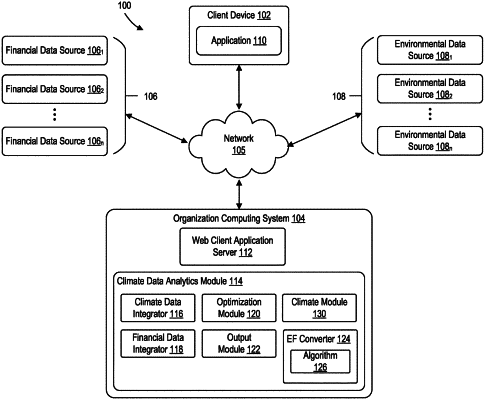| CPC G06Q 40/06 (2013.01) [G06Q 50/06 (2013.01)] | 27 Claims |

|
1. A system, comprising:
a processor; and
a memory having programming instructions stored thereon, which, when executed by the processor, causes the processor to perform an operation, comprising:
receiving, via at least one network, a user selection of a climate change scenario from a remote client device;
retrieving, over the at least one network, energy data from among one or more energy sources, the energy data comprising one or more of simulated future price data, supplier cost data and demand data for the one or more energy sources;
identifying a predetermined number of energy factors according to a principal component analysis (PCA) of the retrieved energy data, based on a correlation of the predetermined number of energy factors with principal components among the retrieved energy data;
retrieving, over the at least one network, historical financial information directed to one or more securities from one or more remote financial data sources;
predicting one or more future returns for the one or more securities, through a simulation of a climate change impact of the one or more energy sources, by applying the historical financial data and the predetermined number of energy factors to at least one hierarchical linear model (HLM), the at least one HLM configured to predict how the one or more remote financial data sources respond to multiple future climate scenarios based on measurable action data among the historical financial data, the measurable action data indicative of a responsiveness of the one or more remote financial data sources to current energy market data, thereby minimizing one or more self-reporting biases among the one or more remote financial data sources;
adjusting the predicted one or more future returns based on a first climate scenario and the selected climate scenario, to form respective first adjusted returns and second adjusted returns;
generating a climate transition risk for the one or more securities based on a spread between the first adjusted returns and the second adjusted returns, the climate transition risk is a metric based on a correlation between the one or more securities and climate sensitivity and indicates an amplitude and direction of the climate sensitivity on a given portfolio of investments including the one or more securities, the climate sensitivity indicating financial effects caused by a transition to the selected climate scenario on the given portfolio of investments including the one or more securities;
providing a data set representing the climate transition risk to the remote client device, the data set including one or more metrics for evaluation of the climate sensitivity of the given portfolio of investments;
responsive to the data set provided to the remote client device, receiving, by the processor, additional user input indicative of an adjustment of the climate sensitivity associated with the evaluation of the one or more metrics; and
adjusting, by the processor, the climate sensitivity by adjusting the one or more metrics provided to the remote client device, in accordance with the additional user input received.
|